Motivation
Industrial nations in general and the United States of America in particular are facing an unprecedented combination of economic and environmental challenges. First, they face the formidable challenge to meet expanding energy needs without adding intolerable amounts of greenhouse gases to the atmosphere and further impacting climate and the environment. The reserves of cheap natural resources the world has been relying on for decades are now estimated in tens of years. Evidence of global warming already gathered around the globe and, most likely, due to industrial activities will put an additional stress on the fragile balance we have been enjoying. In order to face these formidable challenges and to create technological and economic opportunities, the United States should reduce its dependency on foreign fossil fuels and rely more on a combination of (i) sustainable energy conversion and transportation systems, (ii) oil-free energy sources, and (iii) new technologies for capturing and converting carbon dioxide.
The objective of this project is to perform a comprehensive study to simultaneously mitigate carbon dioxide and produce hydrogen. It offers a cheap, efficient, scalable, autonomous, and reliable system for producing hydrogen from microbial consumption of carbon dioxide and absorption of solar light.
Principle
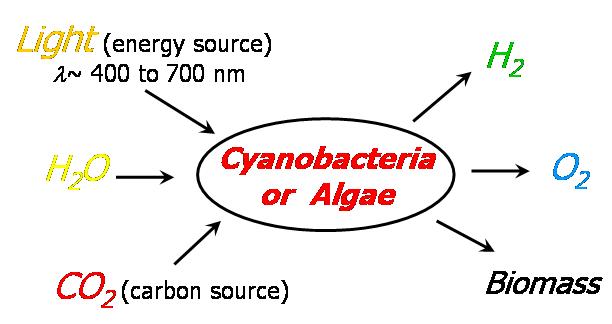
Cyanobacteria produce hydrogen and oxygen by (i) consuming the CO2 gas as their carbon source and (ii) absorbing solar light as their energy source.
Anabaena variabilis
Cyanobacteria Anabaena variabilis are:
- Filamentous, heterocystous cyanobacteria.
- Feature high hydrogen production capacity in the absence of nitrogen.
- Considered to be good carbon dioxide consumer.
- Approximately 5 mm in diameter and 100 mm long.
- Their genome has been sequenced.

Photobioreactor Description and Operation
We have designed and built, and now are operating a fully instrumented photobioreactor. The following measurements are systematically performed:-
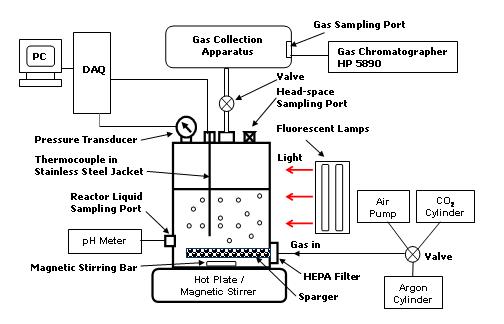
Environment
In the liquid phase -
In the gas phase
Incident light intensity
gas in-flow rate
The photobioreactor is operated using two stages. Switching from Stage 1 to Stage 2 takes place when the nitrate concentrations in the liquid phase vanishes.
Stage 1: Carbon Dioxide Consumption and Bacterial Growth
- presence of nitrates and nitrogen.
- sparging with 95% air and 5% CO2 at 170 mL/min.
- irradiance: 65-75 umol/m2/s.
Stage 2: hydrogen Production
- absence of nitrates and nitrogen.
- sparging with pure Argon at 45 mL/min.
- irradiance: 150 umol/m2/.
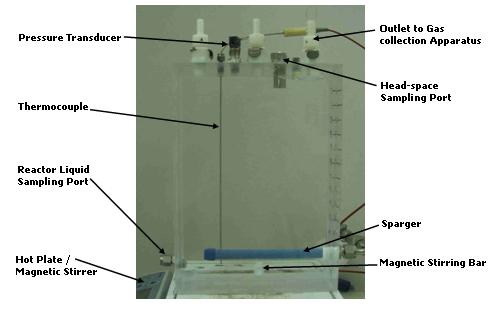
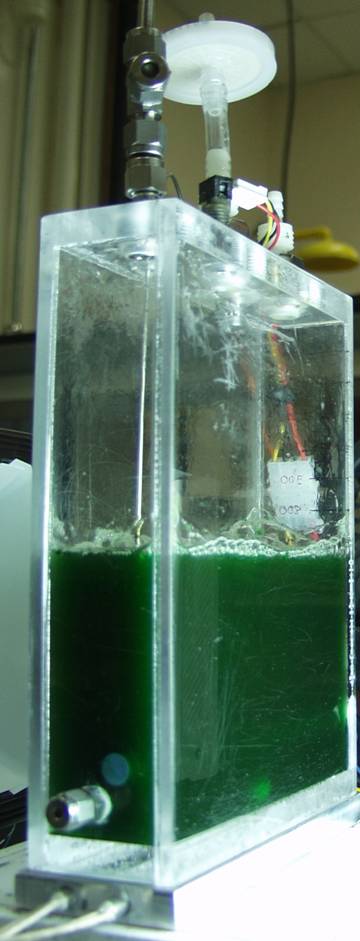
Results
- The growth phase lasted 110 hours.
- The H2 production phase lasted more that a week.
- The light to hydrogen energy conversion efficiency reached 0.5%.
- The light to biomass energy conversion efficiency was 4.7%.
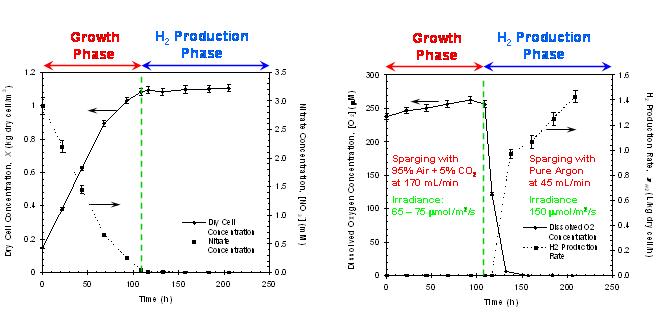
Publications
L. Pilon and H. Berberoğlu, 2014. Photobiological Hydrogen Production. Handbook of Hydrogen Energy, S.A. Sherif, D.Y. Goswami, E.K. Stefanakos, A. Steinfeld, Eds., CRC Press, Taylor and Francis, Boca Raton, FL. ISBN-13: 978-1420054477.
L. Pilon, H. Berberoğlu, and R. Kandilian, 2011. Radiation Transfer in Photobiological CO2 Fixation and Fuel Productionby Microalgae, Journal of Quantitative Spectroscopy and Radiation Transfer, Vol. 112, no. 17, pp. 2639–2660. doi:10.1016/j.jqsrt.2011.07.004 pdf
H. Berberoğlu and L. Pilon, 2010. Maximizing Solar to H2 Energy Conversion Efficiency of Outdoor Photobioreactors Using Mixed Cultures. International Journal of Hydrogen Energy, Vol. 35, pp. 500-510. doi:10.1016/j.ijhydene.2009.11.030 pdf
H. Berberoğlu, P. Gomez, and L. Pilon, 2009. Radiation Characteristics of Botryococcus braunii, Chlorococcum littorale, and Chlorella sp. Used For CO2 Fixation and Biofuel Production, Journal of Quantitative Spectroscopy and Radiative Transfer, Vol. 110, pp. 1879–1893. doi: 10.1016/j.jqsrt.2009.04.005 pdf
H. Berberoğlu, J. Jay, and L. Pilon, 2008. Effect of Nutrient Medium on Hydrogen Production of A. variabilis in a Flat Panel Photobioreactor. International Journal of Hydrogen Energy, Vol. 33, No.4, pp.1172 – 1184. doi:10.1016/j.ijhydene.2007.12.036 pdf
H. Berberoğlu and L. Pilon, 2007. Experimental Measurements of the Radiation Characteristics of Anabaena variabilis ATCC 29413-U and Rhodobacter sphaeroides ATCC 49419, International Journal of Hydrogen Energy,Vol. 32, No. 18, pp.4772-4785. doi:10.1016/j.ijhydene.2007.08.018 pdf
Links
This page has been translated (1) in Norwegian courtesy of Globe Views; (2) in Indonesian by Jordan Silaen courtesy of ChameleonJohn; (3) in Ukranian by Anna Matesh; (4) in Finnish by Elsa Jansson; (5) in Romanian by Sarah Richards courtesy of EWS Translate; (6) in Ukranian by Sandi Wolfe;